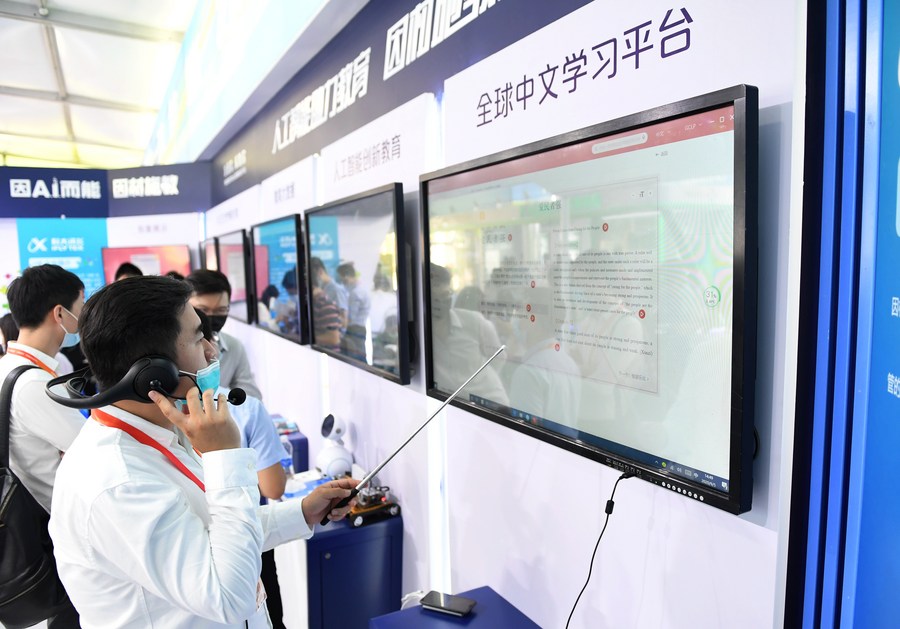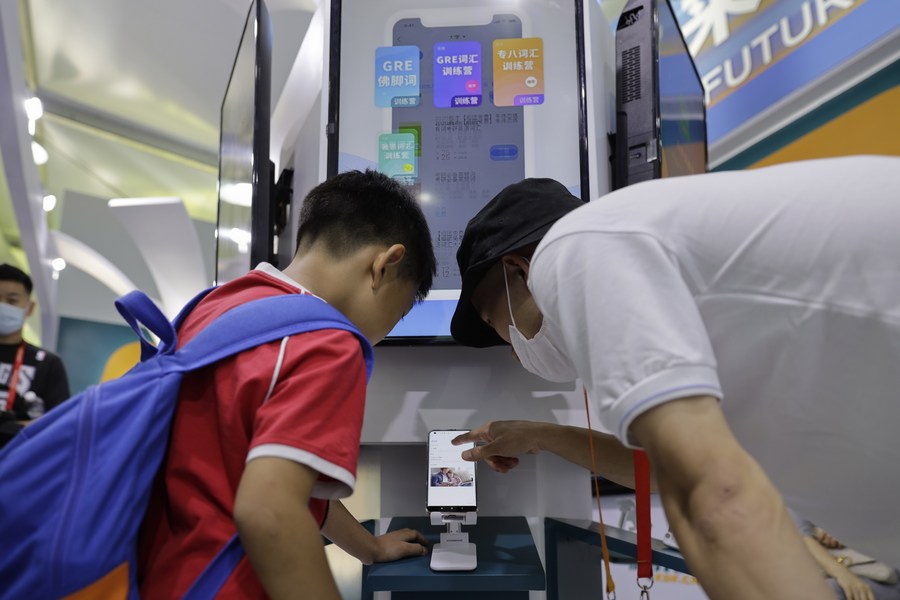
A visitor tries a Chinese-learning system in the education services exhibition area of the 2020 China International Fair for Trade in Services (CIFTIS) in Beijing, capital of China, Sept. 5, 2020.(Xinhua/Zhang Chenlin)
BEIJING, Sept. 7 (Xinhua) -- Though the COVID-19 pandemic has disrupted the global education order, it has provided new opportunities for international education services.
At the ongoing 2020 China International Fair for Trade in Services (CIFTIS), which kicked off Friday in Beijing, educational experts from China and abroad held discussions on how to grab such opportunities in the post-pandemic era.
BLENDED LEARNING IS THE NEW NORMAL
Blended learning has been proposed as the new model for future technology-assisted classrooms by educators participating in the International Forum on Trade in Education Services of the CIFTIS.
Data released by UNESCO shows that a staggering 1.5 billion students in 194 countries have been affected by COVID-19 school closures.
Liu Limin, president of China Education Association for International Exchange (CEAIE), said in his keynote speech that China promptly launched a national cloud platform for primary and secondary schools during the epidemic, and started more than 30,000 free online courses for college students, including 1,291 national quality courses.
"Classrooms on the Air" were also opened for learners in remote areas across the country. All these measures have met the needs of more than 200 million students studying at home.
"It was quite a miracle in the field of global education," Liu said.
The pandemic has promoted the development and use of online teaching resources and changed the role of teachers from imparters of knowledge to guides in learning, said Wang Hongjun, vice principal of Beijing No. 35 High School.
Andreas Schleicher, director of the Directorate of Education and Skills at OECD, said more than half of the schools his organization surveyed regarded blended learning as the new normal for post-pandemic school education.
The convenience of blended learning also offers opportunities for international cooperation, Schleicher noted.

A child learns about an English-learning app in the education services exhibition area of the 2020 China International Fair for Trade in Services (CIFTIS) in Beijing, capital of China, Sept. 5, 2020. (Xinhua/Li Muzi)
NEW OPPORTUNITIES FOR COOPERATIVE EDUCATION
China has established educational cooperation and exchange with 188 countries and regions and 46 international organizations, according to Liu Jin, director of the Department of International Cooperation and Exchanges of the Ministry of Education (MOE).
As the world's largest source of international students with about 1.4 million Chinese now studying abroad, China has also forged agreements with 54 countries on mutual recognition of qualifications and degrees in higher education.
Nick Miles, provost and pro-vice-chancellor of the University of Nottingham Ningbo China (UNNC), said UNNC reopened its campus and became the first Sino-foreign university to resume face-to-face teaching at the end of April, with around 90 percent of domestic students returning.
UNNC had six sample classrooms upgraded to better blend online and offline teaching, with flexible furniture as well as interactive and sharing technologies.
"These technical innovations allow off-campus students to gain a real-time view of instructors and let them easily participate in discussions," Miles said.
Although students might grapple with uncertainty given plans to study abroad due to the pandemic, their enthusiasm for quality educational resources was in no way flagging, according to chancellor Yu Lizhong of New York University Shanghai.
"Sino-foreign cooperative education projects that integrate Chinese culture and overseas educational resources will become a new choice for some students," Yu said.

Visitors communicate with education institution delegates in the education services exhibition area of the 2020 China International Fair for Trade in Services (CIFTIS) in Beijing, capital of China, Sept. 5, 2020. (Xinhua/Li Muzi)
NEW SERVICE FOR OVERSEAS STUDY
At the CEAIE booth at the fair, Liu Qian, a member of CEAIE staff, was busy introducing the AFS intercultural programs to visitors.
"Many people discuss our overseas exchange programs and are concerned whether they could go ahead as planned," Liu said, noting that CEAIE is in contact with schools in some 40 countries and has kept most of its programs running.
According to the Chinese Service Center for Scholarly Exchange affiliated to MOE, the development of online overseas study services brought by the pandemic has increased people's access to information they are concerned about.
The center has made its traditional counter service digital, enabling visitors to experience one-stop online services such as archiving and employment registration.
Educators attending the forum thought that only by opening up and cooperation can international education better share development opportunities in a globalized world.
Despite the impact of the COVID-19 pandemic, China will further deepen cooperation and exchange with other countries in the education sector, Liu Jin said. ■



